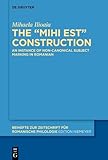The MIHI EST construction : An instance of non-canonical subject marking in Romanian / Mihaela Ilioaia.
Material type: TextSeries: Beihefte zur Zeitschrift für romanische Philologie ; 481Publisher: Berlin ; Boston : De Gruyter, [2023]Copyright date: ©2023Description: 1 online resource (XXII, 334 p.)Content type:
TextSeries: Beihefte zur Zeitschrift für romanische Philologie ; 481Publisher: Berlin ; Boston : De Gruyter, [2023]Copyright date: ©2023Description: 1 online resource (XXII, 334 p.)Content type: - 9783111055022
- 9783111055626
- 9783111055466
- 459.5 23/eng/20240229
- online - DeGruyter
- Issued also in print.
| Item type | Current library | Call number | URL | Status | Notes | Barcode | |
|---|---|---|---|---|---|---|---|
 eBook
eBook
|
Biblioteca "Angelicum" Pont. Univ. S.Tommaso d'Aquino Nuvola online | online - DeGruyter (Browse shelf(Opens below)) | Online access | Not for loan (Accesso limitato) | Accesso per gli utenti autorizzati / Access for authorized users | (dgr)9783111055466 |
Browsing Biblioteca "Angelicum" Pont. Univ. S.Tommaso d'Aquino shelves, Shelving location: Nuvola online Close shelf browser (Hides shelf browser)
Diss. Ghent University 2021.
Frontmatter -- Acknowledgements -- Contents -- List of abbreviations -- List of tables -- List of figures -- Chapter 1 Romanian between Romance and South-East European languages -- Chapter 2 The object of the study -- Part 1: The mihi est construction -- Chapter 3 The mihi est construction as a complex-predicate construction -- Chapter 4 Corpus and methodology -- Chapter 5 Nouns entering the mihi est construction -- Part 2: The subject and its properties -- Chapter 6 The subject: Toward a universal definition -- Chapter 7 Subject properties in Romanian -- Chapter 8 Identifying the subject of the mihi est construction -- Part 3: Expansion of the non-canonical pattern -- Chapter 9 Productivity of the mihi est construction -- Chapter 10 Summary and conclusions -- Bibliography -- Appendices -- Appendix 1 -- Appendix 2 -- Index of subjects -- Index of names
restricted access online access with authorization star
http://purl.org/coar/access_right/c_16ec
This book examines the Romanian mihi est construction (Mi-e foame/frică, me.dat = is hunger/fear ‘I am hungry/ afraid’). While it disappeared from all other Romance languages to be replaced with a habeo structure, the mihi est pattern is in Romanian the most common way of expressing psychological or physiological states. By means of synchronic and diachronic corpus studies, the book investigates the status of the core arguments of the mihi est structure, i.e. the dative experiencer and the nominative state noun, as well as its evolution throughout the centuries. The data analysis reveals that the dative experiencer syntactically behaves like nominative subjects, whereas the state noun shows predicate behavior. As for the evolution of the mihi est structure, the analysis shows a certain tendency toward innovation, since in present-day Romanian it can coerce nouns coming from other semantic fields into the construction’s psychological or physiological interpretation. Could this be another unique trait of Romanian, which causes it to seemingly go against the tendency of most Romance languages toward canonical marking of core arguments?
Issued also in print.
Mode of access: Internet via World Wide Web.
In English.
Description based on online resource; title from PDF title page (publisher's Web site, viewed 25. Jun 2024)









